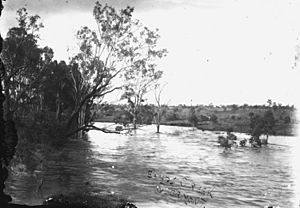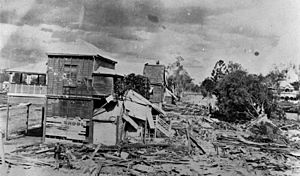Clermont Cemetery facts for kids
Quick facts for kids Clermont Cemetery |
|
|---|---|

Clermont Cemetery, 2007
|
|
| Location | Cemetery Road, Clermont, Isaac Region, Queensland, Australia |
| Built | 1866 |
| Official name: Clermont Cemetery | |
| Type | state heritage (landscape, built) |
| Designated | 6 August 2010 |
| Reference no. | 602756 |
| Significant period | 1868- |
| Lua error in Module:Location_map at line 420: attempt to index field 'wikibase' (a nil value). | |
The Clermont Cemetery is a special historical cemetery located on Cemetery Road in Clermont, Australia. It was first opened in 1866. This cemetery is very important to the history of Queensland. It was added to the Queensland Heritage Register on August 6, 2010.
Contents
History of Clermont Cemetery
The Clermont Cemetery was created in 1866. It was built to serve the new mining town of Clermont in Central Queensland. Since the 1860s, it has been Clermont's only public cemetery. You can find graves here from that early time. In December 1916, Clermont had a terrible flood. It was the worst flood in Queensland's history for loss of life. The cemetery holds the graves of at least 36 people who died in that flood.
How Clermont Town Began
Clermont was one of the first towns built inland in central Queensland. People started farming in the area in the early 1850s. But the town really grew because gold was found nearby around 1861. Many miners rushed to the area. A small tent town quickly appeared. The first hotel, the Diggers' Retreat, opened in 1862.
By late 1863, the area was surveyed. It was officially named Clermont. In the same year, a rich copper mine opened nearby. This led to another town, Copperfield, growing up around the mine. Clermont became a busy and important place. It had a bank, a hospital, and a newspaper office. By 1868, Clermont was the ninth largest town in the colony of Queensland.
In its early years, Clermont depended on gold and copper mining. The surrounding farms and ranches also helped it grow. By the 1870s, the easy-to-find gold was running out. But the town survived because a railway line was built in 1884. This connected Clermont to Emerald and Rockhampton. Later, coal mining at Blair Athol became very important. Today, Clermont is a medium-sized town. It supports coal mines and farms in the area.
The Cemetery's Story
In late 1865, the government approved land for a cemetery in Clermont. It was about 15 acres in size. Cemeteries were usually placed outside of towns. So, Clermont's cemetery was located about one kilometre north-east of the town. It was near Sandy Creek. The cemetery was in use by April 1866. One of the first people buried there was Dr. W.S. Smith. The earliest recorded burial was a two-year-old child in 1867. About 20% of the over 3,000 known burials happened before 1900.
In 1868, trustees were chosen for the cemetery. These were people who managed the cemetery. They represented different Christian churches. Public cemeteries usually had separate sections for different religious groups. Clermont Cemetery is one of the older cemeteries in central Queensland. Others were in St Lawrence (1857) and Rockhampton (1860).
Early cemeteries show us how non-Indigenous people settled in Queensland. Clermont Cemetery is special because of its link to early mining. Goldfields attracted people from all over the world. The graves show people came from China, Germany, Denmark, and many other countries. This shows how diverse the town was during its mining boom.
By the mid-1880s, the cemetery was not well looked after. Fences were falling apart. In 1887, the cemetery land was made bigger. A survey plan from 1886 shows the cemetery had a timber fence. By 1901, a large entrance building was built. It was a timber structure with a gabled roof.
Central and North Queensland often have extreme weather. This includes heavy rain and cyclones. These can cause big floods and loss of life. Clermont had experienced floods before. In 1870, the town was flooded, and four people drowned. But nothing was like the flood of December 1916.
On December 27, 1916, a cyclone hit the coast. It brought huge amounts of rain and strong winds. By December 28, the cyclone was near Clermont. It rained incredibly hard for about 18 hours. Some estimated up to 30 inches of rain fell.
People described a "wall of water" rushing down the creeks. It swept away parts of Clermont town. The cemetery next to the river was also flooded. A newspaper reported that the cemetery was "a mass of holes." Coffins were washed away. Headstones were destroyed or carried far away. The cemetery caretaker's house was washed away, and he drowned.
The river flats were covered by 12 to 14 feet of fast-moving water. People tried to find safety on roofs. But the floodwaters, full of debris, destroyed many houses. Over 60 people died in this disaster. News of the flood spread across Australia and even to London.
Many flood victims were buried where they were found. But at least 36 are buried in Clermont Cemetery. Most were buried within three days of the flood. Whole families, some with up to seven people, were buried together. Victims ranged from two to 70 years old. Most were buried in a large mass grave.
After the flood, people decided to move the town to higher ground. The government passed a special law to help Clermont rebuild. Some buildings were even moved to the new location. Descendants of the flood victims still live in Clermont today. In 1991, a memorial was built in the cemetery. It honors the flood victims. A white cross shows how high the floodwaters reached. The Isaac Regional Council now manages the cemetery. It is still Clermont's main burial ground.
What the Cemetery Looks Like
Clermont Cemetery is in the southern part of a large piece of land. It is about two kilometres north of Clermont town centre. You can enter the cemetery from Cemetery Road. Sandy Creek runs along one side of the property. The northern part of the land is not used as a cemetery.
The graves are set out in a grid pattern. There are dirt or gravel paths between them. Most headstones face east. The oldest graves are at the western end. Newer burials and a lawn cemetery are at the eastern end. Graves here date from 1867 to today. You can see many different styles of monuments from different time periods.
The graves of the 1916 flood victims are in the older, western part of the cemetery. This area is closest to Sandy Creek. Many headstones from before 1916 are made of sandstone, marble, and cast iron. Many show good design and craftsmanship.
The mass grave for the flood victims is surrounded by a low fence. Two other marked graves of flood victims are also inside this fence. One belongs to Richard Hooper. His headstone says he "was drowned in the great flood of Clermont." His wife is also buried there. Another grave lists John Thomas Wicks, Peter Olsson, and Evelyn Olsson. Their inscription says they "were drowned in the flood of Dec 1916."
A memorial from 1991 is also inside the fenced area. It is a granite block with bronze plaques. These plaques name the people and families who died in the 1916 flood. A larger plaque says it was "ERECTED BY LIONESS CLUB ON 13. 4. 1991 IN MEMORY OF KNOWN VICTIMS OF DEC. 1916 FLOOD." Next to it is a tall white timber post. It has a crossbar marking the "1916 FLOOD LEVEL, approximately."
Other flood victims' graves are in the eastern part of the cemetery. One memorial for Margaret Davidson has a marble angel on top of a marble stand. It is surrounded by an iron fence. Another large monument is a marble Celtic cross. It lists five members of the Carsten family. The inscription says it was put up "In loving memory of my dearly beloved wife, little son, mother and sisters who lost their lives in the flood at Clermont, 28 Dec. 1916."
Throughout the cemetery, you can see many types of monuments. These include tall stone pillars and pyramid shapes. Headstones range from simple slabs to very decorated ones. They might have angels, cherubs, or crosses. Materials like marble, sandstone, iron, granite, and concrete were used. Some old cast iron monuments have beautiful metal lace designs. Some monuments were made by famous stonemasons from Brisbane and Melbourne.
The cemetery also has two Commonwealth war graves. These are for an Australian soldier from World War I and an airman from World War II. More recent monuments from the mid to late 1900s are often made of concrete or granite. Many have ceramic tiles.
The lawn cemetery section has wide strips of grass. Some have rows of flowering trees. Small brass plaques mark individual graves.
The main entrance has a metal archway sign. It says "CLERMONT CEMETERY." Mature trees grow around the cemetery, especially on the western and northern sides. A row of Jacaranda trees along Cemetery Road also screens the view. The fences around the cemetery are modern and not considered historical. You can see views of the countryside from the cemetery.
Why Clermont Cemetery is Important
Clermont Cemetery was listed on the Queensland Heritage Register on August 6, 2010. It is important for several reasons:
- It shows how Queensland's history developed.
Clermont Cemetery started in 1866. It is one of the oldest public cemeteries in central Queensland. It shows how Clermont grew as an early mining town. It also shows the many different backgrounds of people who lived in this early mining community. The cemetery is a unique historical record of a town that has served mining, farming, and ranching areas since the 1860s.
The cemetery is also important because of the terrible flood in December 1916. This flood destroyed parts of Clermont and caused over 60 deaths. It was the worst flood in Queensland's history for loss of life. This event led to the town being moved to higher ground. At least 36 flood victims are buried in Clermont Cemetery, mostly in a mass grave. This shows the human cost of Queensland's harsh weather. The cemetery itself was flooded. A marker at the mass grave shows how deep the floodwaters were.
- It has special aesthetic value.
Clermont Cemetery is beautiful because of its monuments and memorials. This is especially true for those linked to the 1916 flood victims. Many early monuments show great craftsmanship. They were often made in other cities and brought to Clermont.



